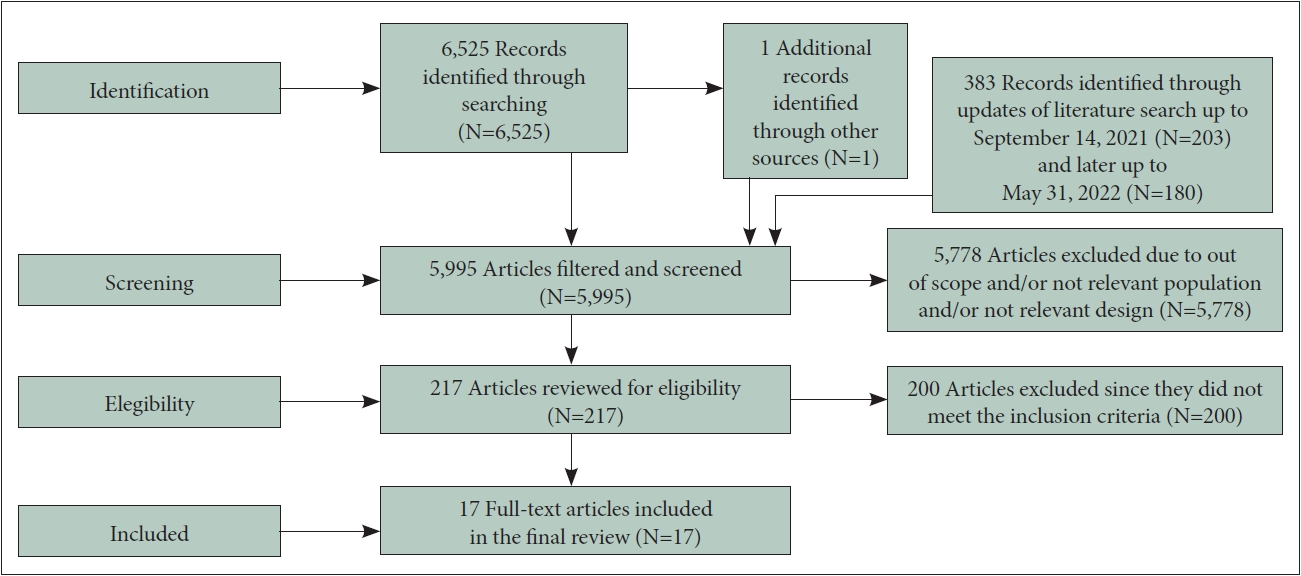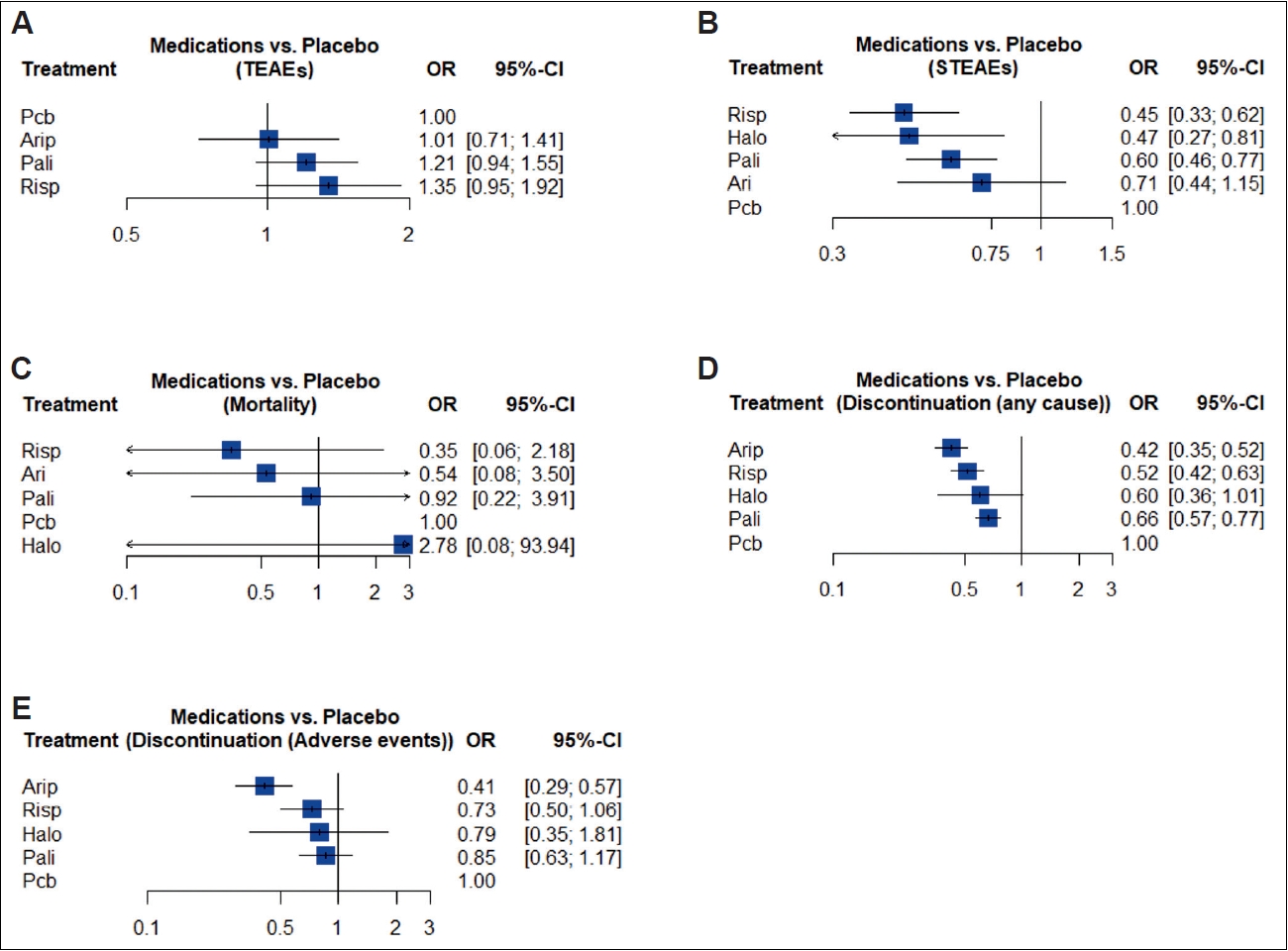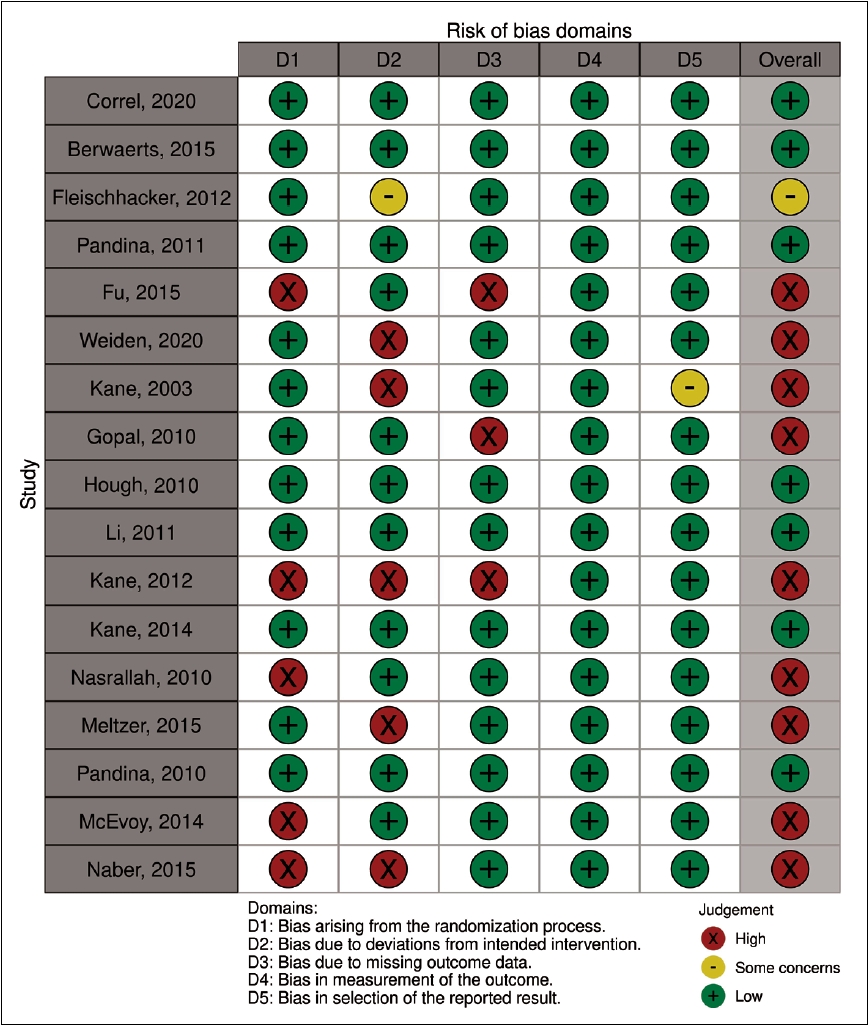 |
 |
- Search
| Psychiatry Investig > Volume 20(12); 2023 > Article |
|
Abstract
Objective
Methods
Results
Conclusion
Supplementary Materials
Supplementary Figure 1.
Supplementary Figure 2.
Supplementary Figure 3.
Supplementary Figure 4.
Supplementary Figure 5.
Supplementary Material 1.
Supplementary Material 2.
Notes
Availability of Data and Material
The datasets generated or analyzed during the study are available from the corresponding author on reasonable request.
Conflicts of Interest
The authors have no potential conflicts of interest to disclose.
Author Contributions
Conceptualization: Erasmo Saucedo Uribe, Samuel Enrique Olivares Mundo, Raul Ricardo Medrano Garza. Data curation: Samuel Enrique Olivares Mundo, Lorena Martinez Sanchez, Martin Moreno Arellano, Yessica Yaneth Herrera Montemayor, Samantha Berenice Medrano Juarez, Sandra Sabrina Rojo-Garza. Formal analysis: Erasmo Saucedo Uribe, Samuel Enrique Olivares Mundo, Raul Ricardo Medrano Garza, Fernando Diaz Gonzalez-Colmenero, Cesar Bigran Espinosa Cantu, Patricia Lizeth Castillo Morales, Samantha Berenice Medrano Juarez, Sandra Sabrina Rojo-Garza. Investigation: Samuel Enrique Olivares Mundo, Raul Ricardo Medrano Garza, Lorena Martinez Sanchez, Yessica Yaneth Herrera Montemayor. Methodology: Erasmo Saucedo Uribe, Raul Ricardo Medrano Garza, Fernando Diaz Gonzalez-Colmenero, Yessica Yaneth Herrera Montemayor. Software: Fernando Diaz Gonzalez-Colmenero, Cesar Bigran Espinosa Cantu, Martin Moreno Arellano, Patricia Lizeth Castillo Morales, Samantha Berenice Medrano Juarez, Sandra Sabrina Rojo-Garza. Validation: Erasmo Saucedo Uribe, Samuel Enrique Olivares Mundo, Fernando Diaz Gonzalez- Colmenero, Patricia Lizeth Castillo Morales. Writing—original draft: Erasmo Saucedo Uribe, Samuel Enrique Olivares Mundo, Raul Ricardo Medrano Garza, Fernando Diaz Gonzalez-Colmenero, Lorena Martinez Sanchez, Cesar Bigran Espinosa Cantu, Martin Moreno Arellano, Yessica Yaneth Herrera Montemayor, Patricia Lizeth Castillo Morales. Writing—review & editing: Erasmo Saucedo Uribe, Samuel Enrique Olivares Mundo, Raul Ricardo Medrano Garza, Fernando Diaz Gonzalez-Colmenero, Lorena Martinez Sanchez, Cesar Bigran Espinosa Cantu, Samantha Berenice Medrano Juarez, Sandra Sabrina Rojo-Garza.
Funding Statement
None
ACKNOWLEDGEMENTS
Figure 1.

Figure 2.

Figure 3.

Table 1.
| Study | Trial name | Intervention | N safety analysis set/population | N TEAEs/N group | N STEAEs/N group | N mortality/N group | N any cause discontinuation/N group | N discontinuation due to adverse events/N group | More frequent TEAEs reported |
|---|---|---|---|---|---|---|---|---|---|
| Berwaerts et al. [36] (2015)/DB | Efficacy and safety of the 3-month formulation of paliperidone palmitate vs. placebo for relapse prevention of schizophrenia a randomized clinical trial | I: PPLAI (175-525 mg eq) 3 months injection intervals | N: 305/Adults 18-70 y/o with SCZ | I: 99/160 | I: 4/160 | I: 0/160 | I: 12/160 | I: 0/160 | I: weight increased, headache, anxiety, insomnia, nasopharyngitis. |
| C: Placebo | C: 84/145 | C: 15/145 | C: 0/145 | C: 23/145 | C: 1/145 | C: insomnia, anxiety, schizophrenia, weight decreased, headache. | |||
| Correll et al. [41] (2020)/DB | Efficacy and safety of once-monthly Risperidone ISM® in schizophrenic patients with an acute exacerbation | I: RisISMLAI (75 and 100 mg) 1 month injection intervals | N: 437/Adults >18 y/o with SCZ | I: 137/290 | I: 7/290 | I: 7/290 | I: 88/290 | I: 15/290 | I: hyperprolactinemia, blood prolactin increased, weight increased, akathisia, somnolence. |
| C: Placebo | C: 32/147 | C: 5/147 | C: 5/147 | C: 59/147 | C: 11/147 | C: injection site pain, weight increased, akathisia, dizziness, headache, somnolence. | |||
| Fleischhacker et al. [28] (2012)/DB | A randomized trial of paliperidone palmitate and risperidone long-acting injectable in schizophrenia | I: PPLAI (25-100 mg eq) 1 month injection intervals | N: 747/Adults >18 y/o with SCZ | I: 289/379 | I: 111/379 | I: 3/379 | I: 224/379‡ | I: 29/379‡ | I: insomnia, psychotic disorder, schizophrenia, anxiety, headache. |
| C: RisRsLAI (25-50 mg) 2 weaks injection intervals+ Ris (1-4 mg) OS | C: 289/368 | C: 80/368 | C: 1/368 | C: 186/370‡ | C: 25/370‡ | C: insomnia, anxiety, psychotic disorder, headache, schizophrenia. | |||
| Fu et al. [37] (2015)/DB | Paliperidone Palmitate once-monthly reduces risk of relapse of psychotic, depressive, and manic symptoms and maintains functioning in a double-blind, randomized study of schizoaffective disorder | I: PPLAI (50-150 mg eq) 1 month injection intervals | N: 334/Adults >18 y/o with SZA | I: 107/164 | I: 9/164 | I: 2/164 | I: 39/164 | I: 12/164 | I: weight increased, hyperprolactinemia, nasopharyngitis, headache, insomnia. |
| C: Placebo | C: 95/170 | C: 16/170 | C: 0/170 | C: 48/170 | C: 3/170 | C: insomnia, schizoaffective disorder, weight increased, nasopharyngitis, headache. | |||
| Gopal et al. [30] (2010)/DB | Efficacy and safety of paliperidone palmitate in adult patients with acutely symptomatic schizophrenia: A randomized, double-blind, placebo-controlled, dose-response study | I: PPLAI (50, 100 and 150 mg eq) 1 month injection intervals | N: 356/Adults >18 y/o with SCZ | I: 175/221 | I: NR | I: 0/221 | I: 109/221 | I: 12/221 | I: headache, insomnia, psychotic disorder, vomiting, nausea. |
| C: Placebo | C: 103/135 | C: NR | C: 0/135 | C: 85/135 | C: 13/135 | C: psychotic disorder, schizophrenia, constipation, agitation, vomiting. | |||
| Hough et al. [31] (2010)/DB | Paliperidone palmitate maintenance treatment in delaying the time-to-relapse in patients with schizophrenia: a randomized, double-blind, placebo-controlled study | I: PPLAI (25-100 mg eq) 1 month injection intervals | N: 408/Adults 18-65 y/o with SCZ | I: 91/205 | I: 11/205 | I: 0/205 | I: 30/205 | I: 3/205 | I: anxiety, insomnia, nasopharyngitis, schizophrenia, headache. |
| C: Placebo | C: 91/203 | C: 26/203 | C: 0/203 | C: 28/203 | C: 2/203 | C: insomnia, schizophrenia, psychotic disorder, depression, nasopharyngitis, headache. | |||
| Kane et al. [29] (2003)/DB | Long-acting injectable risperidone: efficacy and safety of the first long-acting atypical antipsychotic | I: RisRsLAI (25 mg, 50 mg, and 75 mg) 2 weaks injection intervals | N: 400/Adults 18-55 y/o with SCZ | I: 245/302 | I: 42/302 | I: 0/302 | I: 155/302 | I: 37/302 | I: headache, agitation, insomnia, psychosis, anxiety, dizziness. |
| C: Placebo | C: 83/98 | C: 23/98 | C: 1/98 | C: 68/98 | C: 12/98 | C: agitation, psychosis, anxiety, insomnia, headache. | |||
| Kane et al. [34] (2012)/DB | Aripiprazole intramuscular depot as maintenance treatment in patients with schizophrenia: a 52-week, multicenter, randomized, double-blind, placebo- controlled study | I: AriMhLAI (300-400 mg) 1 month injection intervals | N: 403/Adults 18-60 y/o with SCZ | I: 170/269 | I: 11/269 | I: 1/269 | I: 67/269 | I: 19/269 | I: insomnia, weight increased, tremor, headache, anxiety. |
| C: Placebo | C: 83/134 | C: 9/134 | C: 0/134 | C: 73/134 | C: 18/134 | C: weight increased, insomnia, anxiety, akathisia, headache. | |||
| Kane et al. [35] (2014)/DB | Aripiprazole once-monthly in the acute treatment of schizophrenia: findings from a 12-week, randomized, double-blind, placebo- controlled study | I: AriMhLAI (400 mg) 1 month injection intervals | N: 339/Adults 18-65 y/o with SCZ | I: 133/167 | I: 8/167 | I: 0/167 | I: 60/168 | I: 7/168 | I: weight increased, headache, akathisia, constipation, cough, dyspepsia. |
| C: Placebo | C: 122/172 | C: 6/172 | C: 0/172 | C: 87/172 | C: 13/172 | C: headache, weight increased, constipation, dyspepsia, agitation. | |||
| Li et al. [26] (2011)/OL DB | A comparative study of paliperidone palmitate and risperidone long-acting injectable therapy in schizophrenia | I: PPLAI (50-100 mg eq) 1 month injection intervals | N: 452/Adults >18 y/o with SCZ | I: 168/229 | I: 3/229 | I: 0/229 | I: 64/229 | I: 8/229 | I: insomnia, akathisia, tremor, constipation, blood prolactin increased. |
| C: RisRsLAI (25-50 mg) 2 weaks injection intervals+ Ris (1-6 mg) OS | C: 167/223 | C: 8/223 | C: 1/223 | C: 38/223 | C: 9/223 | C: akathisia, tremor, insomnia, restlessness, musculoskeletal stiffness. | |||
| McEvoy et al. [42] (2014)/DB | Effectiveness of Paliperidone Palmitate vs. Haloperidol Decanoate for Maintenance Treatment of Schizophrenia: a Randomized Clinical Trial | I: PPLAI (39-234 mg eq) 1 month injection intervals | N: 294/Adults 18-65 y/o with SCZ and SZA | I: NR* | I: 53/147 | I: 0/147 | I: 104/147 | I: 15/147 | I: insomnia, sleepiness, dry mouth, increased appetite, hypersomnia, sialorrhea.* |
| C: HDLAI (25-200 mg) 1 month injection intervals | C: NR* | C: 45/147 | C: 1/147 | C: 101/147 | C: 14/147 | C: insomnia, sleepiness, dry mouth, increased appetite, hypersomnia, constipation.* | |||
| Meltzer et al. [39] (2015)/DB | A randomized, double-blind, placebo-controlled trial of aripiprazole lauroxil in acute exacerbation of schizophrenia | I: AriLxLAI (441 mg and 882 mg) 1 month injection intervals | N: 622/Adults 18-70 y/o with SCZ | I: 241/415 | I: 7/415 | I: 0/415 | I: 150/415 | I: 20/415 | I: akathisia, insomnia, headache, anxiety, injection site pain. |
| C: Placebo | C: 129/207 | C: 4/207 | C: 0/207 | C: 112/207 | C: 36/207 | C: insomnia, schizophrenia, headache, anxiety, akathisia. | |||
| Naber et al. [40] (2015)/OL DB | Qualify: A randomized head-to-head study of aripiprazole once-monthly and paliperidone palmitate in the treatment of schizophrenia | I: AriMhLAI (400 mg) 1 month injection intervals | N: 228/Adults 18-60 y/o with SCZ | I: 62/119† | I: 6/119† | I: 0/144‡ | I: 44/144‡ | I: 16/144‡ | I: weight increased, insomnia, psychotic disorder, injection site pain. |
| C: PPLAI (50-150 mg eq) 1 month injection intervals | C: 72/109† | C: 8/109† | C: 0/137‡ | C: 54/137‡ | C: 27/137‡ | C: weight increased, insomnia, injection site pain, psychotic disorder, nausea. | |||
| Nasrallah et al. [32] (2010)/DB | A controlled, evidence-based trial of paliperidone palmitate, a Long-acting injectable antipsychotic, in schizophrenia | I: PPLAI (25, 50, and 100 mg eq) 1 month injection intervals | N: 517/Adults >18 y/o with SCZ | I: 275/390§ | I: 43/390§ | I: 1/390 | I: 175/390 | I: 16/390 | I: insomnia, headache, schizophrenia, agitation, psychotic disorder. |
| C: Placebo | C: 91/127 | C: 23/127 | C: 1/127 | C: 79/127 | C: 8/127 | C: insomnia, schizophrenia, headache, psychotic disorder, anxiety. | |||
| Pandina et al. [33] (2010)/DB | A randomized, placebo- controlled study to assess the efficacy and safety of 3 doses of paliperidone palmitate in adults with acutely exacerbated schizophrenia | I: PPLAI (25, 100, and 150 mg eq) 1 month injection intervals | N: 652/Adults >18 y/o with SCZ | I: 301/488§ | I: 50/488 | I: 1/488 | I: 226/488 | I: 34/448§ | I: insomnia, schizophrenia, headache, injection site pain, anxiety. |
| C: Placebo | C: 107/164 | C: 23/164 | C: 0/164 | C: 93/164 | C: 11/164 | C: insomnia, schizophrenia, headache, anxiety, agitation. | |||
| Pandina et al. [27] (2011)/DB | A double-blind study of paliperidone palmitate and risperidone long-acting injectable in adults with schizophrenia | I: PPLAI (50-150 mg eq) 1 month injection intervals | N: 1,214/Adults >18 y/o with SCZ | I: 351/606 | I: 41/606 | I: 2/607‡ | I: 151/607‡ | I: 20/607‡ | I: insomnia, headache, somnolence, injection site pain, schizophrenia. |
| C: RisRsLAI (25-50 mg) 2 weeks injection intervals+Ris (1-2 mg) OS | C: 321/608 | C: 29/608 | C: 0/613‡ | C: 142/613‡ | C: 10/613‡ | C: headache, insomnia, schizophrenia, akathisia, somnolence. | |||
| Weiden et al. [38] (2020)/DB | Efficacy and Safety of a 2-Month Formulation of Aripiprazole Lauroxil With 1-Day Initiation in Patients Hospitalized for Acute Schizophrenia Transitioned to Outpatient Care: Phase 3, Randomized, Double-Blind, Active-Control ALPINE Study | I: AriLxLAI (1,064 mg) 2 months injection intervals | N:200/Adults 18-65 y/o with SCZ | I: 69/99 | I: 8/99 | I: 0/99 | I: 43/99 | I: 10/99 | I: injection site pain, increased weight, akathisia, headache, schizophrenia. |
| C: PPLAI (156-234 mg) 1 month injection intervals | C: 72/101 | C: 7/101 | C: 0/101 | C: 58/101 | C: 11/101 | C: injection site pain, increased weight, akathisia, headache, dystonia. |
‡ N events and/or N group extracted after randomization and/or from treated patients only when not available or clear in safety analysis set;
§ we calculated the average of the percentage range when individual percentages or frequencies were not available.
TEAEs, treatment emergent adverse events; STEAEs, serious treatment emergent adverse events; N, number of patients included in each group/outcome; DB, double blind; I, intervention; C, comparator; PPLAI, paliperidone palmitate long acting injectable; eq, equivalence; y/o, years old; SCZ, schizophrenia; RisISMLAI, risperidone in situ microimplants long acting injectable; RisRsLAI, risperidone risperdal long acting injectable; OS, oral supplementation; SZA, schizoaffective disorder; NR, not reported; AriMhLAI, aripiprazole monohydrate long acting injectable; OL, open label; HDLAI, haloperidol decanoate long acting injectable; AriLxLAI, aripiprazole lauroxil long acting injectable
REFERENCES
- TOOLS
-
METRICS

-
- 0 Crossref
- Scopus
- 1,332 View
- 65 Download
-
Diagnostic Neuroimaging in Headache Patients: A Systematic Review and Meta-Analysis2019 June;16(6)








